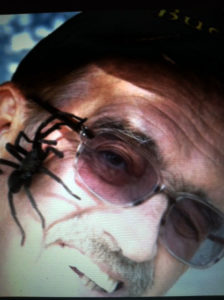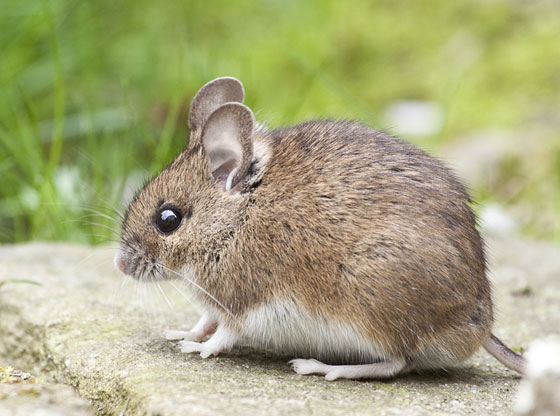The deer mouse is one of the most common rodent species found throughout most of the United States . They are 4” – 9” long, are reddish-brown in color with a white chest, white feet, and a bi-colored tail: brown on top and white on bottom.
Their natural habitat is in rural and semi-rural areas, where they inhabit fields, pastures, and various types of vegetation found around homes and outbuildings. This mouse commonly invades garages, attics, sheds, wood piles, crawl spaces, as well as general living quarters of homes.
Mice can enter 1/4” openings – or they can be carried inside. They may get in through broken windows, poorly screened attic and foundation vents, openings through any walls created by cable, oil, propane, electric, gas, water and/or sewage services, and through any other openings or cracks or crevices in foundations, walls or roofs. They can also chew holes directly through siding and/or window or door frames.
While house mice (Mus musculus) aren’t linked to Hantavirus, they are very prolific and very unpleasant to have infesting your home. Under optimum conditions, house mice breed year round.
Out-of doors, house mice may tend toward seasonal breeding, peaking in the spring and fall. Females may produce as many as ten litters (about 50 young) in a year. At very high densities, however, reproduction may nearly cease despite the presence of excess food and cover.
Although mice primarily are active at night, some day activity occurs. Movements of house mice are largely determined by temperature, food, and hiding places.
Mice are very curious and tend to travel over and explore and re-explore their entire territory daily, investigating each change or new object that may be placed there. They are very aggressive. They show no fear of new objects. They dart from place to place, covering the same route over and over again.
This behavior can be used to advantage in control programs. Disturbing the environment at the beginning of a control program by moving boxes, shelves, pallets, and other objects can improve the effectiveness of traps, glue boards, and bait. Mice will investigate the changed territory thoroughly. This is why (live catch) traps work so well.
House mice prefer cereals over other items, although they will feed on a wide variety of foods. Mice sometimes search for foods high in fat and protein, such as lard, butter, nuts, bacon, and meat. Sweets, including chocolate, are taken at times. Mice get much of their water from moisture in their food, but they will drink if water is readily available.
Mice in buildings catch and eat flies, spiders, centipedes, cockroaches, beetles, millipedes and other arthropods. Outdoors house mice consume a wide variety of weed seeds, grass seeds, various grains and vegetation.
In addition, they consume many insects and other invertebrates, e.g., slugs, spiders and centipedes. When caught in a live trap, mice trapped later may eat the first, weaker captive(s).
Here are some recommendations for managing mice in your home or business.
Keep rodents out of garages, sheds or barns by keeping access to water, food and nesting materials and harborage areas away from them, especially within 100 feet of your occupied buildings.
Repair all holes in buildings that would allow rodents entry. Open doors and windows before cleaning areas where rodents have been living. If possible, run an electric fan for at least half an hour to clear out dust. Leave the areas while the fan is on.
Disinfect sites where you have seen rodents or their droppings. General-purpose disinfectants will kill the virus. A mixture of three tablespoons of household bleach in a gallon of water can also be used. Spray the area and mop, rather than sweeping or vacuuming. The wetter the area, the better because dampness will keep the dust down.
Remember that the territory of mice rarely extends further than 30 feet from the nest, and more often is about 10 feet.
If mice are sighted throughout a building, it means that there are numerous discrete locations where you will have to set traps. When using live traps, oatmeal is a very effective bait.
On snap traps, a piece of Slim Jim is almost irresistible to mice. It is much more effective than cheese or peanut butter. When you find a mouse in a snap trap, spray it with a disinfectant and put it in a plastic bag before disposing of it. Never use snap traps outside as they can injure or kill birds or other innocent animals.
Never use rodenticides for several reasons.
First, if a mouse dies where you can’t find it you will have an odor problem. Also if the mouse (particularly deer mice) have ectoparasites such as fleas or mites, they will leave the dead carcass and may attack the human occupants of the house.
Mice should always be controlled with snap or live traps. If you have a crawl space under your house, you should have it mouse-proofed. Trapping with snap traps or live traps will work for rats as well. Basically the control methods are similar with both animals.
If you live in an area where mice or other rodents like to get under the hood of your vehicle and chew on the wires, then you should read this.
The best way to keep them from under the hood, is to get some cotton balls, soak them in peppermint essential oil, place them in little paper cups and put them in various places under the hood, especially around wiring. Rodents will not go under the hood of a vehicle that smells like peppermint. Much better than rodenticides or traps which rarely work at all in this situation.
Written by Richard Fagerlund
About Richard Fagerlund:
Richard “Bugman” Fagerlund spent years in the pest management business, and then 11 years working with the University of New Mexico as a pest specialist, an Entomologist (insect expert), and Dipterist (specialist in flies).
Richard’s latest book is “Richard ‘Bugman’ Fagerlund: My Path to the Bugman with an Earth-Friendly Guide to Pest Management for Your Home and Garden.”
Richard is the co-author of “Ask the Bugman” and “The Bugman on Bugs”, as well as the co-author of three scholarly papers during his time with UNM. He wrote weekly natural pest control columns that appeared in many newspapers nationwide, including the San Francisco Chronicle and the Albuquerque Tribune.
When he retired from the University of New Mexico in 2006, Richard went into pest management consulting, and continues to help businesses control pests using least-toxic methods today. He still writes occasional columns for various papers, because he enjoys helping people solve their pest problems without having to use toxic pesticides. He has received hundreds if not thousands of letters from readers across the country.
Contact Richard at [email protected].


















